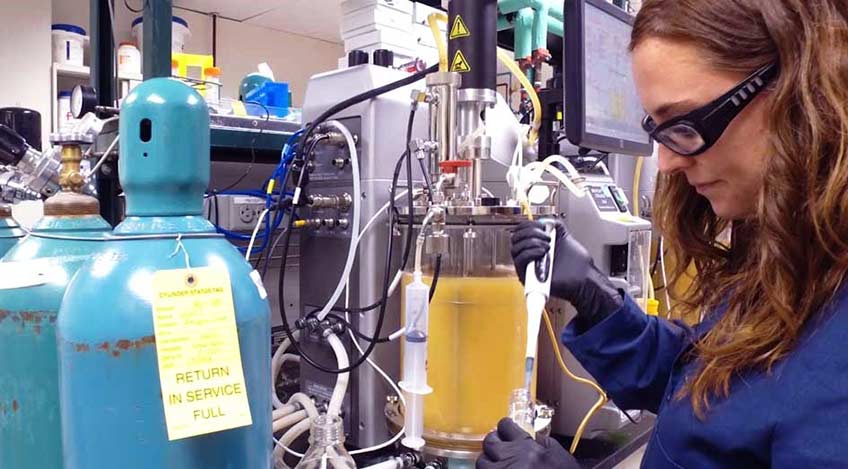Nitrilation Process Produces Acrylonitrile, Attention, and Awards

Violeta Sánchez i Nogué is a member of the research team that pioneered NREL's nitrilation-to-acrylonitrile process—a multi-award winning technology.
A clean, cost-competitive pathway to a $7 billion market is an attention grabber. NREL’s nitrilation process to produce a bio-based acrylonitrile has done just that. In recent months the new technology has grabbed attention … and awards. This summer alone, the process technology has been recognized with the Federal Laboratory Consortium (FLC) Mid-Continent Region Notable Technology Development Award, the CO-Labs Governor’s Award, and has been named a 2018 R&D 100 Award finalist.
“We’ve long been excited about the prospects of the nitrilation chemistry,” said NREL Associate Laboratory Director Adam Bratis, who was the principal investigator of the Renewable Carbon Fiber Consortium where the research got its start. “It’s nice to see that others are recognizing its potential, too.”
The award-winning research that led to the nitrilation process development was an interdisciplinary collaboration of researchers across chemical engineering, biology, and computational modeling, including NREL’s Bratis, Gregg Beckham, Eric Karp, Violeta Sànchez i Nogué, and Vassili Vorotnikov, as well as other contributors from NREL, the University of Colorado Boulder, the Colorado School of Mines, Oak Ridge National Laboratory, Johnson Matthey, and the Mid-Atlantic Technology, Research & Innovation Center.
Their goal was a cleaner path to acrylonitrile, a major commodity chemical employed in many diverse, commercial applications—from clothing to carpets to plastics.
Additionally, acrylonitrile can be polymerized to polyacrylonitrile, which is the primary building block in carbon fiber composites. Because of its many advantageous physical properties—high strength, light weight, high temperature tolerance, and high chemical resistance—carbon fiber has become extremely important in today’s world. Its unique properties have made it popular in the civil engineering, military, and motorsports industries, as well as in an increasing number of other consumer and technical applications including increasing wind turbine efficiency.
Perhaps most importantly, carbon fiber can be used for lightweighting applications in automotive and air transportation, as well as the aerospace industry—replacing heavier materials like steel with lightweight carbon fibers to lower vehicle weight and improve fuel efficiency. For example, replacing the steel and aluminum used in today’s cars would result in the fuel economy of the average car increasing by nearly 50% and greenhouse gas emissions being reduced by 20%–40%. As a result, the demand for carbon fibers is projected to increase 11%–18% annually.
Unfortunately, nearly all commercial acrylonitrile is produced today via an energy-intensive, chemically hazardous, petroleum-based process. But times are changing.
Nitrilation Process—What’s Old Is New Again
NREL’s new nitrilation technology produces near-100% yields of cost-competitive acrylonitrile—representing a huge market—from non-food biomass. A renewable alternative to the petrochemical method, nitrilation eliminates toxic byproducts, requires less energy, uses inexpensive catalysts, and can be performed in a simple reactor configuration with no explosion hazards.
The process is fundamentally different from the ammoxidation chemistry used in industry to produce acrylonitrile today. Unlike ammoxidation, which uses propylene from petroleum or natural gas, nitrilation can take advantage of the functionality present in bio-based feedstocks—such as the oxygen present in the plants—to produce fewer toxic byproducts in a safer reactor environment with simpler catalysts.
Developing the new process took time and research and the “aha moment” came when NREL’s team uncovered a paper written in 1916 demonstrating how to transform an oxygen-containing feedstock (like biomass) into a nitrile product. NREL’s team combined chemical insights from this 1916 report and others from 1973 and 1987 to develop the strategy to produce acrylonitrile. A bonus: They did it in a reactor configured similarly to those already used in industry today.
Accolades
In presenting the Notable Technology Development Award to NREL, the FLC Mid-Continent Region selection committee said they considered the nitrilation process "an industry changing technology" and "the very definition of a disruptive technology."
The CO-Labs Governor’s award is presented to a technology produced in the state of Colorado that has a significant impact on society. The selection committee made up of researchers from Colorado’s research universities, professional scientific community, and science-oriented economic development experts recognized the technology as “brilliant research.”
And, R&D Magazine recently announced that the nitrilation process to acrylonitrile is a 2018 R&D 100 finalist and recognized it as one of the nation’s top technology products of the past year. The final R&D 100 winners will be announced in November.
Find more information on NREL’s nitrilation process in Science, “Renewable Acrylonitrile Production,” and on nrel.gov, “NREL Develops Novel Method to Produce Renewable Acrylonitrile.”
Last Updated May 28, 2025
